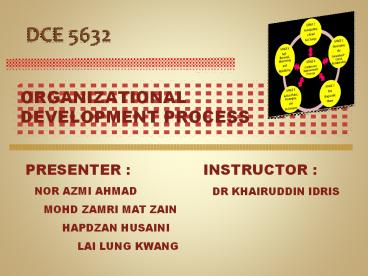DCE 5632 - PowerPoint PPT Presentation
1 / 27
Title: DCE 5632
1
DCE 5632
- ORGANIZATIONAL
- DEVELOPMENT PROCESS
2
Organizational Development Process The Model
3
Gary N.McLean (2005). Organization Development
Principles, Processes, Performance. San
Francisco, USA Berrett-Koehler.
4
Retrieved from http//en.wikipedia.org/wiki/Organi
zation_development based on the Kurt Lewin Model
of Action research
5
Retrieved from http//hrpeople.monster.com
6
Retrieved from http//www.authorstream.com/Present
ation/Bharathisunagar-347048-5-managing-od-process
-entertainment-ppt-powerpoint/
7
Stage 1 Anticipating a need for change
8
Stage 1 Anticipating a need for change
- Organization /leader recognizes that a problem
exists which impact the effectiveness, mission
health of organization. - Leadership has a vision of a better way and wants
to improve the organization in term of
performance. - Dissatisfaction with the present situation.
- To achieve the first steps towards reaching the
desired vision. - Business is not as usual
9
Stage 2 Developing the Consultant Client
Relationship
10
Stage 2 Developing the Consultant Client
Relationship
11
Stage 2 Developing the Consultant Client
Relationship
12
Stage 3 The Diagnostic Phase
INTRODUCTION
WHY DIANOGSIS to identify system parameters and
recognize symptoms, problems, and causes of the
organization effectiveness
13
- Figure of The diagnostic process
Tentative Problem Areas Identified
1
4
6
Data Feedback
Problem Areas Identified
3
More Data Needed Now
2
Collect Data
NO
More Data Needed Now
5
Client Target Motivated To Work on Problem
YES
7
No Change At Present
NO
YES
Diagnosis Work on Problem Causes. Result is Change
8
14
Diagnostic Models
is used to analyze the organization as a
socio-technical system interacting with its
external environment
Cause maps are mathematical representations of
perceived causal relationships among variables.
Among the most important factors such as
quantity, speed, frequency, quality, morale, and
so forth)
This technique assumes that at any given moment
an organization is in a state of
equilibrium/balanced
15
The Method of Diagnosis
16
Evaluating The Effectiveness Of Diagnosis
17
(No Transcript)
18
Stage 4 Action Plans, Strategies and Techniques
19
TYPE OF INTERVENTIONS TYPE OF INTERVENTIONS TYPE OF INTERVENTIONS TYPE OF INTERVENTIONS
STRATEGIES INDIVIDUAL TEAM INTERGROUP TOTAL ORGANIZATIONAL SYSTEM
BEHAVIORAL Career planning Team building Goal setting Intergroup development Goal setting Survey feedback
BEHAVIORAL Goal setting Stress management Quality control TQM TQM Action Research
STRUCTURAL Job enrichment Job enrichment Job enrichment Goal setting Restructuring Survey feedback
STRUCTURAL Stress management Team building TQM TQM
TECHNOLOGICAL Job design Job design Job design Survey feedback Action research
TECHNOLOGICAL Quality control TQM TQM Reengineering
20
Stage 5 Self-Renewal, Monitoring and Stabilizing
- Self renewal
- Conceived of as a response to routine and lack of
intellectual stimulation, which characterize many
occupations in our society (Gardner,1964 Hudson,
1991). - Organization renewal define as an ongoing process
of building innovation and adaptation into
organisation
21
Stage 5 Self-Renewal, Monitoring and Stabilizing
- Evaluation and monitoring
- Model of five alternative ways to evaluate
- Ask the expert
- Whats the target
- Did we hit the target
- Mid course correction
- Continues monitoring
- (Weiss Rein, 1970)
22
Stage 5 Self-Renewal, Monitoring and Stabilizing
- Stabilizing
- process maintenance phase.
- takes place under conditions of unfreeze ness
which are necessary for the changes to have an
impact once introduced - however it is necessary that the changed system
should stabilize to allow the changes to permeate
the culture of the organization. - The process consists of activities to maintain
the effectiveness of the intervention by
receiving feed back about the change produced
modifications
23
Stage 6 Continous Improvement Process
- CIP IS
- An ongoing effort to improve products, services
or processes - through intervention.
- WHY NEED CIP ?
- Organization environment became more-more
competitive - and business became usual.
- Only two type of organization - those that are
changing and - those that are going out of business.
- HOW TO DO?
- Continuously introduce changes through repeating
the cycle - of organization development process.
24
INCORPORATED DEMING CYCLE (PDCA) IN OD
Define and analyze the current process
Develop and implement plan
Action Correction , Prevention, Engraft and
plan next CP
Study the approaches, technique result
Also known as Deming Cycle and made it famous by
Dr W. Edwards Deming PDCA model was introduced
by Walter A Shewhart
25
OTHERS MODEL OF CONTINUOUS IMPROVEMENT
- KAIZEN
- BENCHMARKING
- TQM
26
CONCLUSION
- Organization need to continuously introduce
changes through repeating the cycle of
organization development process for continues
existing in the market.
27
Thank you































